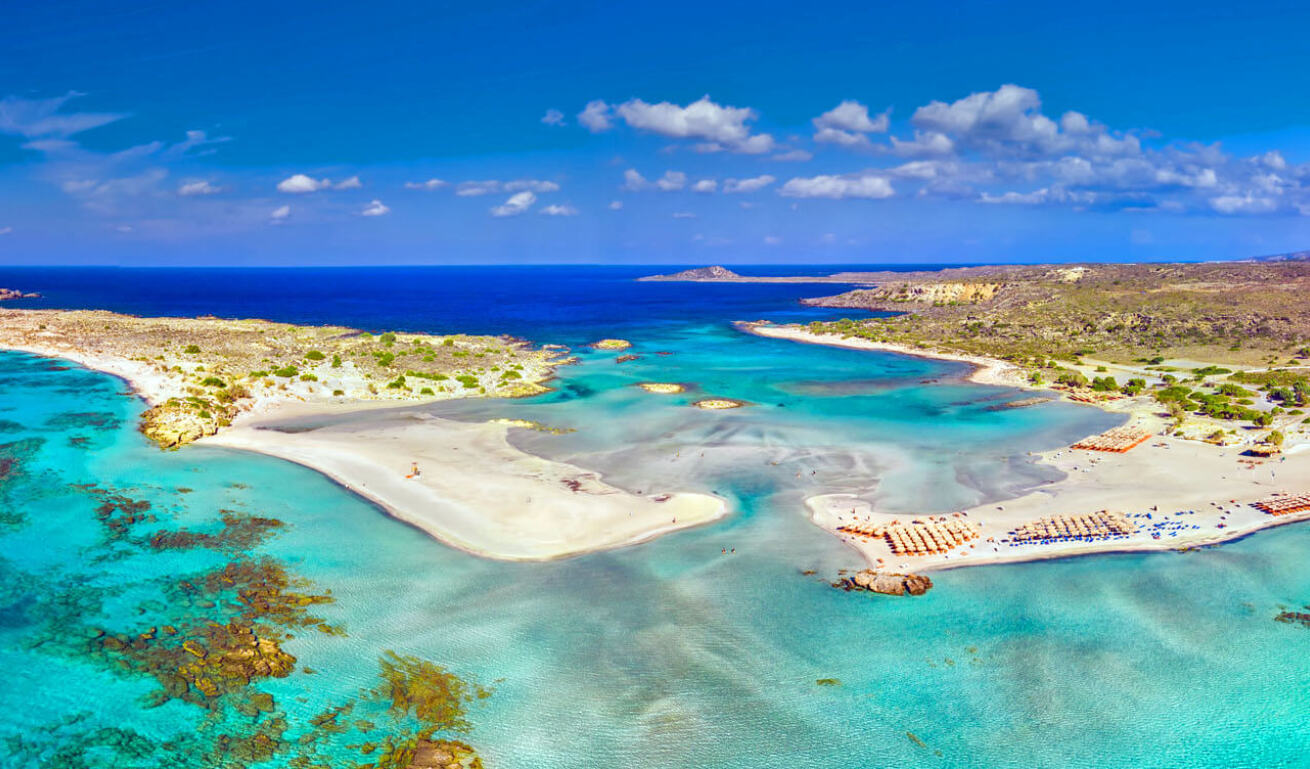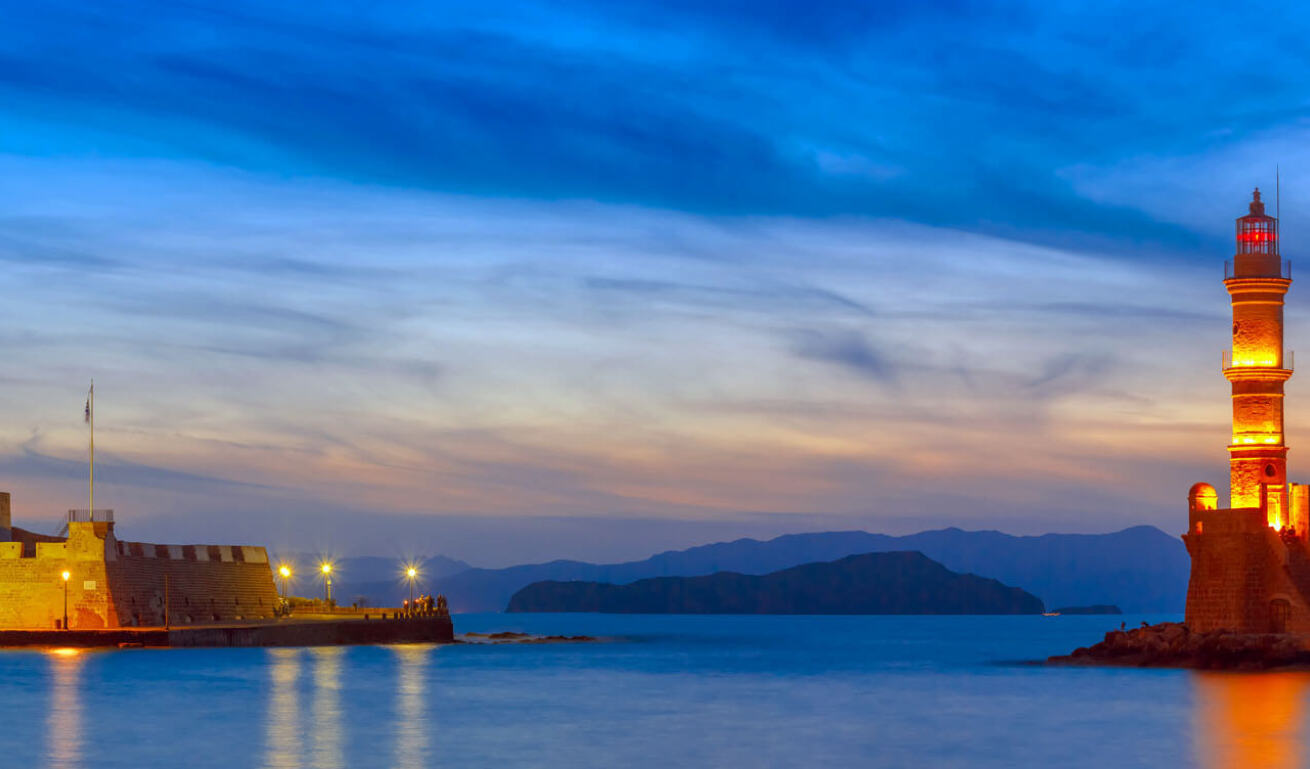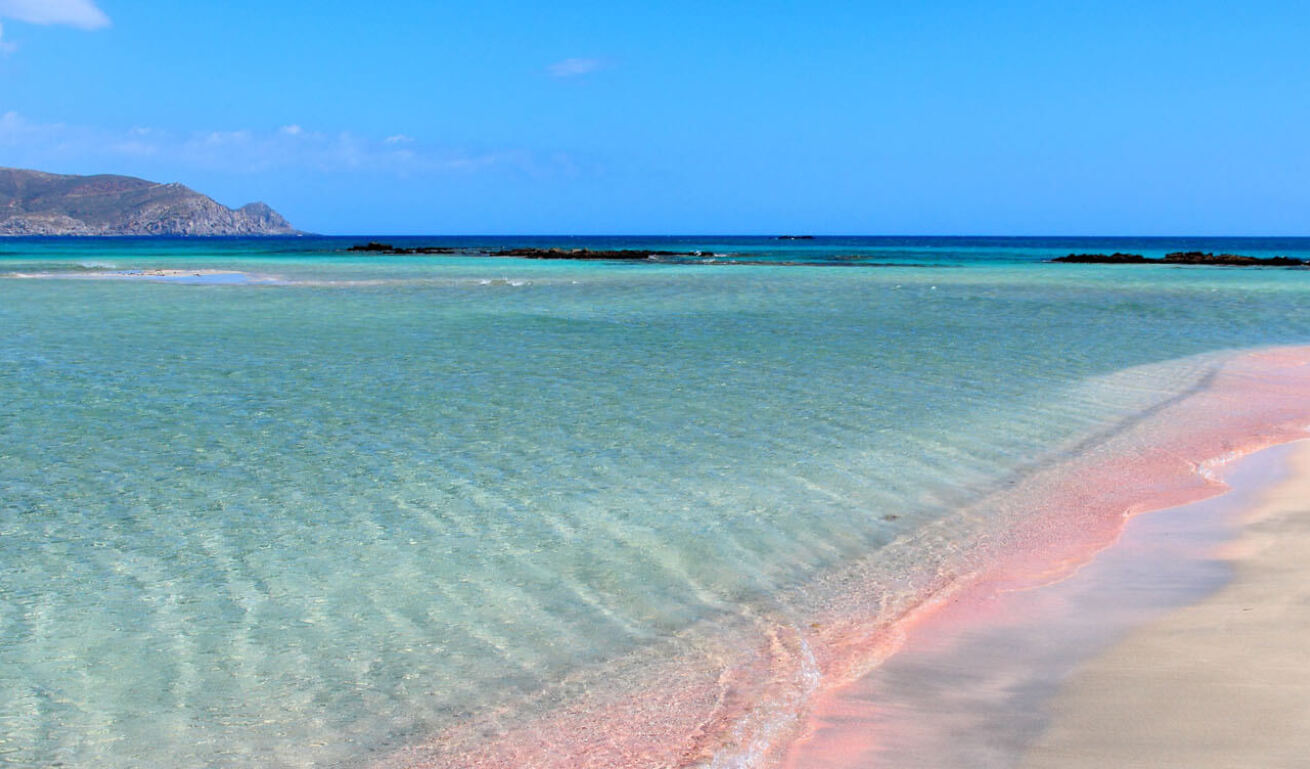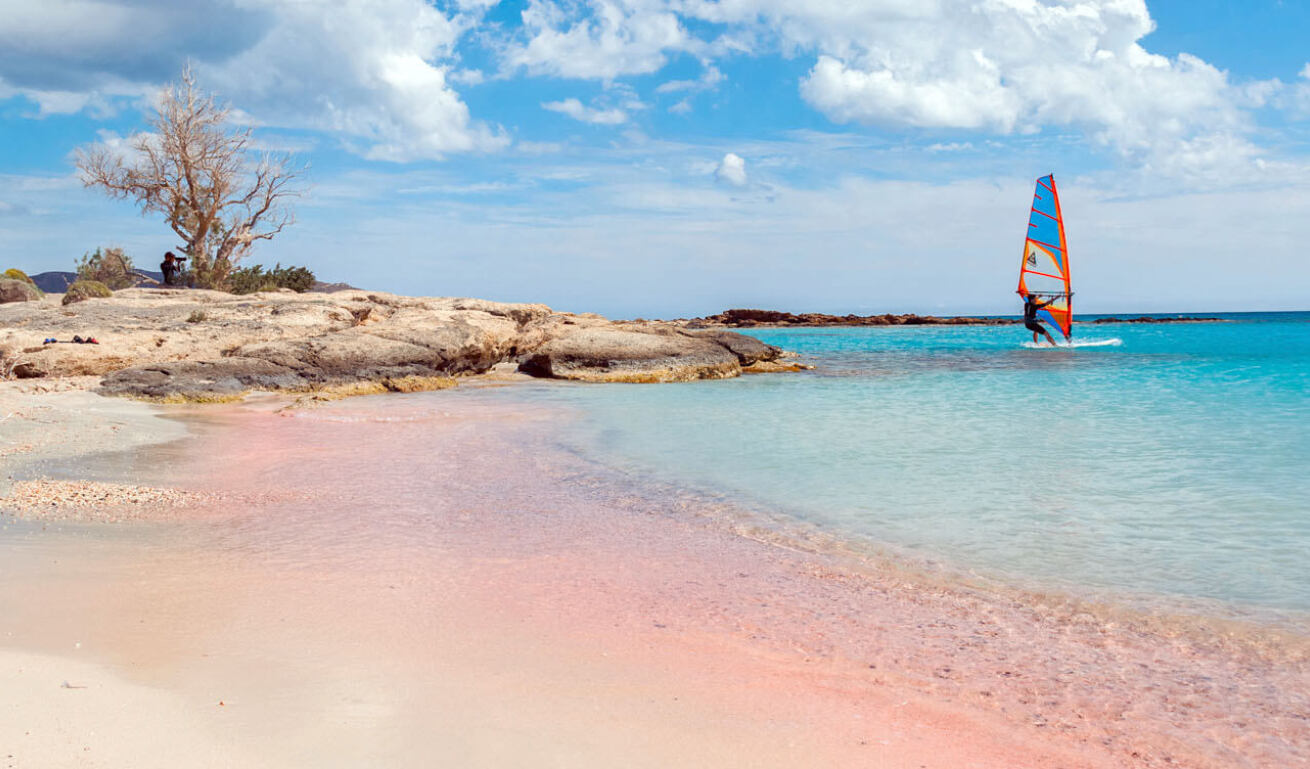

Crete
Simply Has It All!
Crete is the largest island in Greece, and the fifth largest one in the Mediterranean Sea. Here, you can admire the remnants of brilliant civilizations, explore glorious beaches, impressive mountainscapes, fertile valleys and steep gorges, and become part of the island’s rich gastronomic culture.
In 2025, UNESCO added six Minoan palace centres in Crete to its World Heritage List, recognizing their outstanding universal value and the pivotal role they played in Europe’s earliest advanced civilization. These include Knossos, Phaistos, Malia, Zakros, Zominthos, and Kydonia – all iconic sites of the Bronze Age Minoan world.
Crete is, after all, a small universe teeming with beauties and treasures that you will probably need a lifetime to uncover!



Where to go...

Chania
Chania is a city where different civilizations have flourished throughout the centuries. Strolling around the Old Town’s maze-like alleys with the beautiful Venetian mansions, the fountains and the churches will guide you through well-preserved historical monuments.
Chania is built on the prehistoric city of Kidonia, at the bay formed between Akrotiri and Onicha peninsulas. It was the former capital city of Crete (from 1847 until 1972). Nowadays, it is the second largest city on the island, after Heraklion.
Visit Chania and wander in the city streets, see its museums and admire the different architectural styles.

Rethymno
Rethymno is located in the north end of the prefecture, built by the sea and is a city with many faces. Rethymno or Rithymna as it was once called has been inhabited since the Later Minoan III period. Nowadays, it keeps the elements inherited by its history (from antiquity up to now), preserving at the same time the characteristics of a modern city. You can reach Rethymno by boat from Piraeus or by plane from Athens to Chania and then drive 60 km to Rethymno.

Heraklion
Heraklion is the largest city of Crete and one of Greece’s major urban centres. The city flourished under a multicultural influence throughout the centuries; that’s why there is a plethora of Byzantine, Venetian and Ottoman structures to look out for!
In 2025, UNESCO inscribed six Minoan palace centers in Crete – including Knossos, located just outside Heraklion – on the World Heritage List. This major recognition highlights the universal value of the island’s Minoan heritage and its profound contribution to early European civilisation. The designated sites include Knossos, Phaistos, Malia, Zakros, Zominthos, and Kydonia, all of which were flourishing hubs of the Bronze Age Minoan world (2800–1100 BCE). These archaeological treasures offer a direct link to Crete’s ancient past, and Heraklion is the perfect gateway to explore them.
The city’s landmark is the 16th c. Koules fortress in the westernmost side of the old Venetian port, which along with the fortification walls (dating back to the same period) are among the most significant and imposing sights.

Agios Nikolaos
Agios Nikolaos (“Ag Nik” as the British visitors love to call it) is the capital town of Lassithi. Here, the bottomless salt lake Voulismeni dominates the area. A narrow channel of water connects the lake with the sea, while an imposing backdrop of red rock and trees adds to the natural beauty of the scenery. A small pine tree park lies above the lake, and a stone path leads to its southern section to a cute small harbour for fishing boats.
The city boasts interesting Archaeological, Folklore, and Natural History museums, Byzantine churches, a well-organised marina, bustling pedestrian streets (ideal for leisurely walks), and traditional squares with buzzing cafés and restaurants.
10 reasons to fall in love with Crete
1. Civilisation & Culture
Its strategic location on the map has turned the island of Crete into a crossroads where peoples and civilisations have left a permanent mark on, along with a rich cultural heritage. Across the ages, Minoans, Mycenaeans, Ottoman Turks, Arabs and Venetians have shaped the island’s identity.
Discover Crete’s eventful history that spans fifty-odd centuries: explore the Minoan palace centres of Knossos, Phaestos, Malia, Zakros Zominthos and Kydonia - all inscribed by UNESCO in 2025 as World Heritage Sites. These key centers of the Bronze Age Minoan civilization flourished between 2800 and 1100 BCE and represent the earliest example of monumental architecture, urban planning, and artistic achievement in Europe. Continue your cultural journey at the archaeological sites of ancient Gortyna, Eleftherna, Lyttos, Aptera, Falasarna, Spinalonga; the Venetian harbours at Chania, Heraklion and Rethymno towns; the ottoman monuments and architectural structures seen across the island; the historic monasteries of Arkadi, Preveli, Toplou, Agarathou, and Chrysoskalitissa; numerous thematic museums – the Heraklion Archaeological Museum is among the most significant in Europe.
2. Old Towns
The old towns of Chania and Rethymno share a fascinating combination of Venetian and Ottoman architectural elements. They are well-known, charming, and much-photographed with an ambience reminiscent of times gone by. Stroll along their narrow alleys and streets, stop by and have a coffee, snack or meal in the traditional cafes and tavernas; the magical patina of old times is everywhere.
3. Traditional Villages
They are mountain villages, mostly. Old customs and traditions are kept unchanged here and they unveil aspects of the true Cretan culture. Visit Archanes, Zaros and Asites in Heraklion region, Vamos and Chora Sfakion in Chania region, Anogeia, Axos and Margarites in Rethymno region, Makrygialos and Kritsa in Lasithi region. This is the ‘heart’ of traditional Crete.
4. Seaside Tourist Resorts
Luxury resorts and lodgings of all types can be found along the seafront. Big towns such as Heraklion, Chania, Rethymno, Agios Nikolaos, Siteia and Ierapetra are not the only destinations that can offer you a vacation to remember: visit also Agia Pelagia, Amnissos, Kaloi Limenes, Chani Kokkini, Malia and Ammoudara (Heraklion region); Platania, Agia Marina, Kolympari, Agia Roumeli, Loutro, Palaiochora and Kissamos in Chania region; Georgioupoli, Bali, Plakia, Agios Pavlos, Panormos in Rethymno region; Elounta, Plaka, Makrygialos, Koutsounari, Agia Fotia in Lasithi region.
5. Gastronomy
The essence of the Cretan cuisine can be described in the following words: “prefer the products of your land”. The way locals make use of their land’s rich produce is remarkable. The wide variety of seasonal fruits and vegetables, legumes, wild edible greens and fragrant herbs are combined with tasty goat and sheep meat: the outcome is a number of particularly tasty dishes that don’t come up anywhere else in Greece. The local cheese list is also quite impressive; on the top you will find the popular Cretan graviera (a type of hard cheese) which is a PDO cheese.
6. Beaches
The island’s endless coastline features numerous beaches, most of which are sandy. Balos, Falasarna and Elafonisi are three beaches of great beauty in the region of Chania. Within a short distance from Heraklion you will find Amnissos, Agia Pelagia, Kaloi Limenes, Malia, Limenas Chersonisou, Ammoudara beaches. Don’t miss out on visiting Matala beach known since the sixties and seventies as a hotspot for hippies who travelled there from all over the world.
In Rethymno you will find the longest sandy beaches (Episkopi, Petres) and a number of quite unusual beaches (Triopetra, Agios Pavlos, Ligres, Fragokastelo, Preveli). The area of Lasithi is well-known for its picturesque shores that are washed by the Libyan Sea, as well as for cosmopolitan Elounta beach.
7. Nature’s Amazing Creations
The terrain’s morphological diversity is remarkable and it offers hard-to-ignore opportunities to daring explorers and nature lovers for extensive tours of the countryside. High mountains with rugged peaks, caves and ravines, fertile plateaus and valleys, rare cedar forests and water habitats are the pieces that make up the lovely and diverse Cretan land. Make a note of visiting Mt. Psiloritis (or Psiloritis) Natural Park and Siteia (or Sitia) Natural Park - both are UNESCO Global Geoparks, discover caves celebrated in ancient Greek mythology such as Idaion Antron, Diktaion Antron, Melidoni and Sfendoni, hike along Samaria gorge, enjoy a ramble in Vai palm forest, Lakes Kourna & Preveli, as well as on Lasithi and Nida plateaus.
8. Activities
Crete is an island that can offer many a thrill to action-loving travellers by the sea or on the mountain. Hike through its ravines, enjoy your off-road rides in the mainland, follow the trekking routes – the landscapes crossed by the E4 European trail are amazing; enjoy water sports activities such as sailing, diving, sea kayaking and windsurfing.
9. Paradise Islands
Visit Gavdos islet, the southernmost tip of Europe; swim by heavenly beaches such as Sarakiniko, Ai Giannis, Pyrgos, Potamos, Trypiti; discover cedar woods that reach the seashore and well-tended trails that lead to the few island villages. In the summertime the place is a popular camping spot. There is a boat connection with Palaiochora, Sougia and Chora Sfakion.
Chrysi or Pontikonisi islet (8 miles south of Ierapetra) is a feast for the eyes, what with its turquoise waters, the off-white sands enriched with the hues of broken seashells, and the huge seaside cedars rooted in the sand dunes. Every day hundreds of visitors come to the island for a day trip aboard the tourist boats from Ierapetra. Chrysi islet has been designated a Natura 2000 area and it is strictly forbidden to camp and spend the night there.
Koufonisi, Siteia (or Lefki islet) is a place that few people know. There are caves shaped in the limestone rocks that contain vestiges of significant antiquities. The sandy beaches and natural serenity is what makes this islet a paradise - one that only locals are aware of; they usually take a trip there using their own boats. There is however a small boat that will take you from Makrygialos to Koufonisi. This islet is a pristine area with no facilities of any kind, so make sure you carry the essentials for your trip with you.
10. A Natural Way of Life
The Cretans are proud and affable people. They are, after all, the descendants of Cretan-born Zeus the god of hospitality and father of all ancient Greek gods. And they know how to offer hospitality to strangers in their parts. Their profound love for their homeland and their adherence to traditional ways and customs have shaped a special culture and a way of life that is absolutely worth discovering. And if you happen to be invited to a Cretan feast, you will feel what it’s like to have fun - the way locals do. You will savour tasty titbits and dishes, and you’ll be called to join in the folk dances; you will listen to mantinades (songs with words improvised and sung on the spot) and rizitika songs.
Have a great time – the Cretan way!

Local Dishes
VIEW ALL
Tips for your Trips
VIEW ALL
The Old Port Area of Chania
Chania’s Venetian Harbour was carefully built in the 14th century for commercial purposes and for protection against pirate raids. Today it is a point of reference for the city of Chania, and a much-photographed place with a touch of magic!

Geoparks in Greece
Greece is a land shaped by dramatic geological forces. Over millions of years, continuous mountain formation has sculpted a landscape rich in striking natural monuments and breathtaking formations.

Explore the east part of Crete

Take part in a traditional harvest activity!

13 Oscar winning beaches
The first thing that comes to mind when you think about Greek summer are the endless coasts and the charming seashores that “flirt” with the magical waters of the Aegean, Ionian and Lybian Sea.




